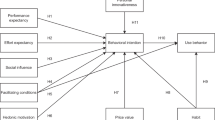Abstract
Video-mediated communication (VMC) has become a feasible way to connect people in remote places for work and play. Nevertheless, little research has been done with regard to children and VMC. In this paper, we explore the behavior of a group of children, who exchanged video messages in an informal context. In particular, this paper presents the results of 11-week VMC study of 30 children from the USA and Greece, exploring children’s behavior with the asynchronous video-based messaging tool we developed called VideoPal. In the study, children’s interactions, perceptions, content exchanged and emotions were collected. The results from the analyses highlight that the emotion of happiness dominated in the communication. Moreover, the content included useful personal information and is connected with children’s interactions (e.g., number of views and of recipients). In addition, children generally preferred VideoPal to email because they felt that it was easier and has more fun.



Similar content being viewed by others
References
Tassabehji R, Vakola M (2005) Business email: the killer impact. Commun ACM 48(11):64–70
Du H, Inkpen KM, Chorianopoulos K, Czerwinski M, Johns P, Hoff A, Roseway A, Morlidge S, Tang J, Gross T (2011) VideoPal: exploring asynchronous video-messaging to enable cross-cultural friendships. In: Proceedings of the twelfth European conference on computer-supported cooperative work—ECSCW 2011, pp 273–292
Giannakos MN, Chorianopoulos K, Johns P, Inkpen K, Du H (2011) Children’s interactions in an asynchronous video mediated communication environment. In: Proceedings of 13th IFIP TC13 conference on human−computer interaction, pp 199–206
Yarosh S, Inkpen KM, Brush AJ (2010) Video playdate: toward free play across distance. In: Proceedings CHI 2010, pp 1251–1260
Piaget J (1926) The language and thought of the child, Harcourt. Brace, NY
Marcoccia M (2004) On-line polylogues: conversation structure and participation framework in internet newsgroups. J Pragmat 36(1):115–145
Herring SC (1999) Interactional coherence in CMC. J Comput Mediat Commun 4(4). http://jcmc.indiana.edu/vol4/issue4/herring.html
Ballagas R, Kaye J, Ames M, Go J, Raffle H (2009) Family communication: phone conversations with children. In: Proceedings of interaction design for children 2009, pp 321–324
Sellen AJ (1995) Remote conversations: the effects of mediating talk with technology. Hum Comput Interact 10:401–444
Doherty-Sneddon, GD, O’Malley C, Garrod S, Anderson A, Langton S, Bruce V (1997) Face-to-face and video-mediated communication: a comparison of dialogue structure and task performance. J Exp Psychol Appl 3:105–125
van der Kleij R, Schraagen, J, Werkhoven P, De Dreu C (2009) How conversations change over time in face-to-face and video-mediated communication. Small Group Res 40(4):355–381
Hancock JT, Dunham PJ (2001) Impression formation in computer-mediated communication revisited: an analysis of the breadth and intensity of impressions. Commun Res 28:325–334
Ferrara K, Brunner H, Whittemore G (1991) Interactive written discourse as an emergent register. Writ Commun 8(1):9–33
Daft RL, Lengel RH (1984) Information richness: a new approach to managerial behavior and organizational design. Res Organ Behav 6:199–233
Short J, Williams E, Christie B (1976) The social psychology of telecommunications. Wiley, Hoboken, NJ
Ames M, Go J, Kaye J, Spasojevic M (2010) Making love in the network closet: the benefits and work of family videochat. In: Proceedings of the CSCW 2010, pp 145–154
O’Neill R, Colley A (2006) Gender and status effects in student e-mails to staff. J Comput Assist Learn 22:360–367
Druin A, Inkpen K (2001) When are personal technologies for children? Pers Ubiquit Comput 5(3):191–194
Soloway E (1991) How the Nintendo generation learns. Commun ACM 34(9):23–28
Guiller J, Durndell A (2007) Students’ linguistic behaviour in online discussion groups: does gender matter? Comput Hum Behav 23:2240–2255
Straus SG, McGrath JE (1994) Does the medium matter: the interaction of task and technology on group performance and member reactions. J Appl Psychol 79:87–97
Riordan MA, Kreuz RJ (2010) Emotion encoding and interpretation in computer-mediated communication: reasons for use. Comput Hum Behav 26(6):1667–1673
Frijda NH (1986) The emotions. Cambridge University Press, Cambridge
Kay RH, Loverock S (2008) Assessing emotions related to learning new software: the computer emotion scale. Comput Hum Behav 24:1605–1623
Oatley K, Johnson-Laird PN (1987) Towards a cognitive theory of emotions. Cogn Emot 1(1):29–50
Lombard M, Snyder-Duch J, Bracken CC (2002) Content analysis in mass communication: assessment and reporting of inter-coder reliability. Hum Commun Res 28:587–604
Zuckerman O, Maes P (2005) Awareness system for children in distributed families. Paper presented at interaction design for children 2005. http://web.media.mit.edu/~orit/IDC05_Zuckerman.pdf. Retrieved 19 April 2012
Komlodi A, Alburo J, Preece J, Druin A, Hou W, Liao S, Elkiss A, Resnik P (2007) Evaluating a cross-cultural children’s online book community: lessons learned for sociability, usability, and cultural exchange. Interact Comput 19(4):494–511
Zhang D, Zhou L, Briggs RO, Nunamaker JF (2006) Instructional video in e-learning: assessing the impact of interactive video on learning effectiveness. Inf Manag 43:15–27
Wilfong J (2006) Computer anxiety and anger: the impact of computer use, computer experience and self-efficacy beliefs. Comput Hum Behav 22(6):1001–1011
Acknowledgments
The authors would like to express their gratitude to all of the children who participated in the experiment. We also thank Ilias Pappas who assisted us in the content analysis procedure. The work reported in this paper has been partly supported by Project CULT (http://cult.di.ionio.gr). CULT (MC-ERG-2008-230894) is a Marie Curie Project of the European Commission (EC) under the 7th Framework Program (FP7).
Author information
Authors and Affiliations
Corresponding author
Rights and permissions
About this article
Cite this article
Giannakos, M.N., Chorianopoulos, K., Inkpen, K. et al. Understanding children’s behavior in an asynchronous video-mediated communication environment. Pers Ubiquit Comput 17, 1621–1629 (2013). https://doi.org/10.1007/s00779-012-0525-2
Received:
Accepted:
Published:
Issue Date:
DOI: https://doi.org/10.1007/s00779-012-0525-2




